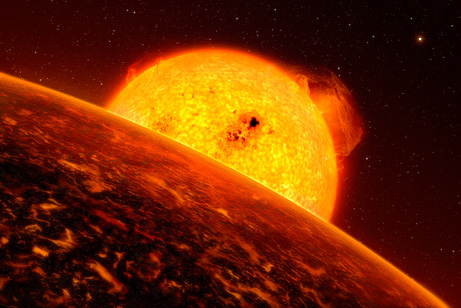Hail on the new planet CoRoT-7b
The first rock planet discovered outside the solar system has a terrifying habitat full of hail on the lava sea, a recent study said.
500 light years away from the Earth in the constellation Monoceros, CoRoT-7b was first discovered in February by the French and European agency through the CoRoT telescope.
Recently the planet has been confirmed that the earth-like shape is full of gravel - but it is similar to our planet.
CoRoT-7b is twice as big and 5 times heavier than Earth, and it is 1.5 million miles from its star (2.5 million km) - 23 times more than the distance from Mercury to the face. heaven of the earth. On the planet CoRoT-7b a year lasts 20.4 hours.
'The reality of this planet's orbit has just been discovered,' said a member of the research group Laura Schaefer, an astronomer at Washington University, St. Louis. Louis, Missouri.
Hail
Because the newly discovered planet has orbits very close to its star, it is locked in a smaller shape. Half of the planet faces its star, like the one side of the moon always facing the earth.
 CoRoT-7b, the first rock planet discovered outside the solar system. (Photo: Southern European Observatory)
CoRoT-7b, the first rock planet discovered outside the solar system. (Photo: Southern European Observatory)
A new computer model of CoRoT-7b was made by Schaefer and her team suggested that the surface of the planet on the opposite side of the star has a burning temperature of 4,220 degrees F (2,327 degrees C).
While the earth is covered by the surface of the water, CoRoT-7b is covered by rock surface, the study said.
From the surface facing the star, rocks and minerals evaporate more and more, creating a thin layer of atmosphere. At higher altitudes, this substance hardens into a 'rock cloud' and creates hot hail of various compounds on the planet's surface.
Pebbles from this rain are often small, Schaefer said.'We are probably talking about the size of the dust.'
If gravel falls into lakes and lava seas, they will return to the planet's rock cycle. However, if the stone clouds were pushed away by the wind to the other side of the dark and icy planet, the stones remained in the hard form as they fell to the surface, Schaefer said.
Studies are detailed in the October 1 issue of the Astrophysical Journal Letters.
- Volcanic hell in the universe
- Ten strange planets of the universe
- Why hail, how to prevent hail
- Hail fell again in Lao Cai
- 10 'hell' planets for humans
- Heavy hail in Da Lat caused heavy damage
- Looking ahead to the future of the Earth
- Big hail 'never seen' lasted two hours in Quang Nam
- The strange object disturbs the classification of extraterrestrial planets
- Nghe An: Again hail appeared in Ky Son mountainous district
- 10 things you may not know about hail
- Lao Cai again caught heavy hail
 Van Allen's belt and evidence that the Apollo 11 mission to the Moon was myth
Van Allen's belt and evidence that the Apollo 11 mission to the Moon was myth The levels of civilization in the universe (Kardashev scale)
The levels of civilization in the universe (Kardashev scale) Today Mars, the sun and the Earth are aligned
Today Mars, the sun and the Earth are aligned The Amazon owner announced a secret plan to build a space base for thousands of people
The Amazon owner announced a secret plan to build a space base for thousands of people